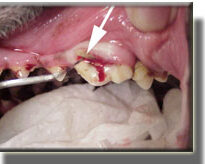
Crowns or “Caps” are used to replace missing tooth structure with a laboratory fabricated metal or ceramic material. Certainly, most teeth in dogs and cats do not require crown restoration, but in some cases they are beneficial. Hunting and working dogs frequently damage their canine teeth (fangs). Working dogs, such as those used for police and protection work, can place forces over 1500 pounds per square inch on their teeth when biting forcefully. Loss of function in these teeth can lead to decreased work performance.
Cage chewer lesions.
In some cases, dogs wear down the backs of their fangs chewing on cages or fences. Often the enamel is completely worn away, weakening these teeth dramatically. These defects are commonly referred to as “cage chewer lesions”. Restoration with a partial or full crown can decrease sensitivity and help prevent future fracture in these weakened teeth.
Fractured upper carnassial tooth.
The major chewing teeth in dogs in the back of the mouth are termed the “Carnassial Teeth”. These large teeth are frequently fractured, which is painful and impairs normal chewing function for the patient. Full function can be restored in many cases by placing a crown on the damaged tooth.








